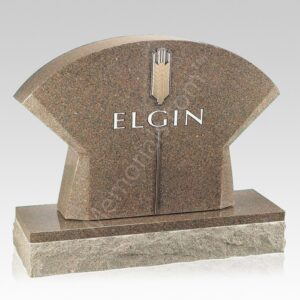A Rich and Interesting History
Memorial headstones have been, for centuries, the most common way to permanently memorialize members of cultures all across the globe. And they remain so today. Even people whose bodies have been cremated (a tradition whose popularity is increasing dramatically) are typically memorialized with memorial headstones installed in cemeteries, often in a family plot.
For many years, memorial headstones were large, up-right pieces of sculpted stone that contained written information about the people whose grave they marked. While these “up-right” memorial headstones still are used today, they now usually mark groups of graves (such as entire families). Meanwhile, smaller, individual flat memorial headstones are now the most common type. These are smaller plaque-like pieces made of bronze, granite, or a combination of the two, are displayed directly on the ground at the head of a grave. These memorial headstones typically memorialize one individual or a couple.
Memorial headstones today most commonly come in two varieties: bronze and granite. The American memorial industry specializes in both styles today, and, while, granite headstones are still most popular, bronze is rapidly gaining in popularity. (And it should be noted that many bronze memorial headstones include a free bronze vase, if the customer desires one.) Bronze memorial headstones typically include bronze plates with special memorial designs and lettering that names the deceased as well as the dates of birth and death. These plates are then attached to granite bases and then installed in cemeteries as beautiful memorial headstones.

Memorial headstones, of course, serve to help families cope with their losses. By having memorial headstones for loved-ones always available to view in specific locations, families are practicing the sound advice that psychologists typically give to those going through the grieving process. But, besides their emotional value, memorial headstones are also important for historians. Memorial headstones assure that lives can be documented decades, or even centuries, after death. The study construction of memorial headstones assures that the people being memorialized will be remembered long after the elements have destroyed paper records or technology has made electronic records obsolete.
Memorial headstones can be purchased either “pre-need” or “at-need.” Pre-need memorial headstones are bought while a person is still alive. These memorial headstones have the name (or, in the case of companion memorial headstones, names) inscribed at the time of purchase, and then the death dates are added later. Many people choose this option because they want the peace of mind that comes from choosing the design and style of their own memorial headstone. Memorial headstones purchased pre-need can also provide a financial benefit in the event prices increase for memorial headstones during a person’s lifetime. Despite the advantages of pre-need buying, many family members buy memorial headstones for their loved-ones “at-need.” The decision of when to buy memorial headstones is deeply personal, and both methods are popular today.
